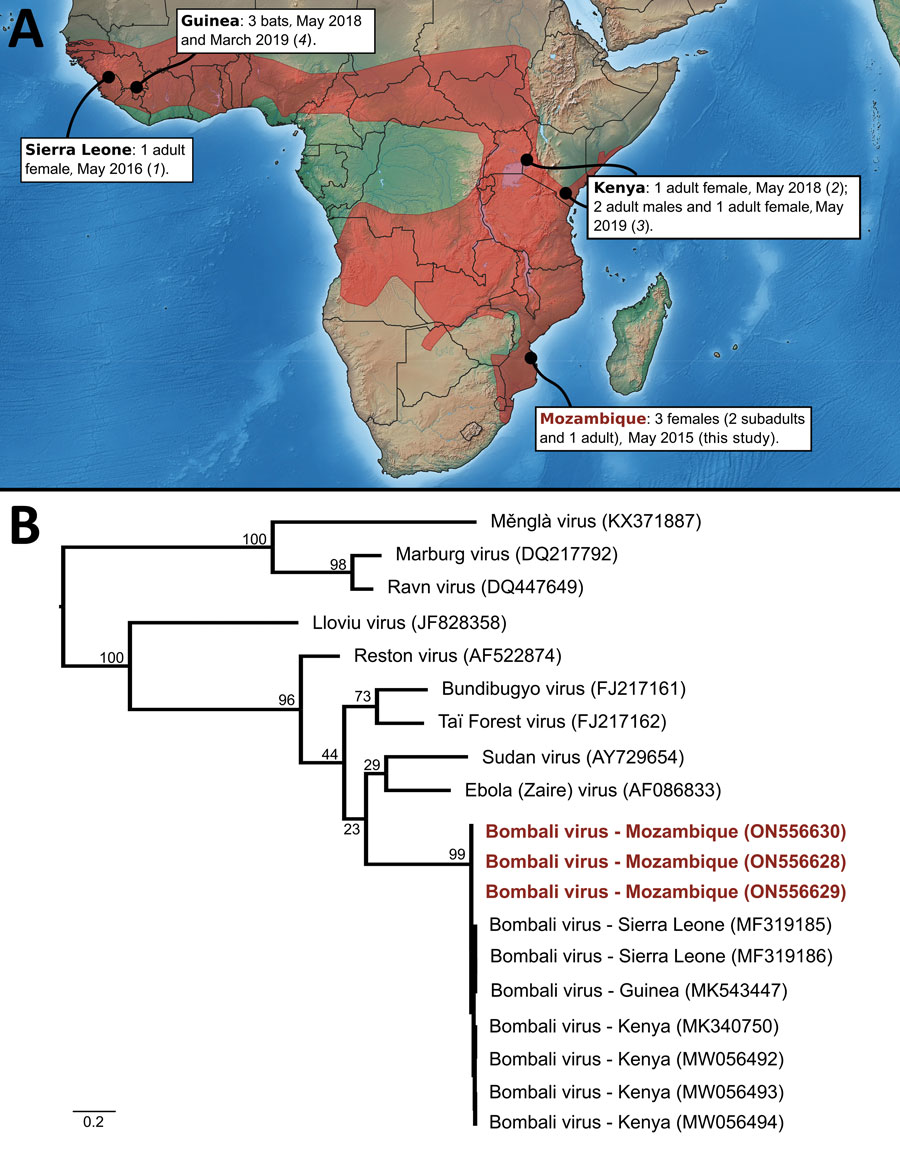Volume 28, Number 12—December 2022
Research Letter
Bombali Ebolavirus in Mops condylurus Bats (Molossidae), Mozambique
Figure

Figure. Bombali virus detection in Angolan free-tailed bats (Mops condylurus). A) Geographic range highlighted in red. Information regarding the sex of positive M. condylurus bats in Guinea is not available (4). The map was generated with data available from Natural Earth (https://www.naturalearthdata.com) and the International Union for Conservation of Nature Red List Web site (https://www.iucnredlist.org). B) Maximum-likelihood tree based on partial nucleotide sequences (587 bp) of the large protein gene of selected filoviruses. Red indicates sequences generated in this study. The phylogenetic analysis was conducted with the transversion plus gamma evolutionary model (α = 0.32) and 1,000 bootstraps (Appendix). All but 1 of the Bombali virus were detected in Mops condylurus bats, with the exception of MF319186, which collected from a Chaerephon pumilus bat (1).
References
- Goldstein T, Anthony SJ, Gbakima A, Bird BH, Bangura J, Tremeau-Bravard A, et al. The discovery of Bombali virus adds further support for bats as hosts of ebolaviruses. Nat Microbiol. 2018;3:1084–9. DOIPubMedGoogle Scholar
- Forbes KM, Webala PW, Jääskeläinen AJ, Abdurahman S, Ogola J, Masika MM, et al. Bombali Virus in Mops condylurus bat, Kenya. Emerg Infect Dis. 2019;25:955–7. DOIPubMedGoogle Scholar
- Kareinen L, Ogola J, Kivistö I, Smura T, Aaltonen K, Jääskeläinen AJ, et al. Range expansion of Bombali virus in Mops condylurus bats, Kenya, 2019. Emerg Infect Dis. 2020;26:3007–10. DOIPubMedGoogle Scholar
- Karan LS, Makenov MT, Korneev MG, Sacko N, Boumbaly S, Yakovlev SA, et al. Bombali virus in Mops condylurus bats, Guinea. Emerg Infect Dis. 2019;25:1774–5. DOIPubMedGoogle Scholar
- Hoarau F, Le Minter G, Joffrin L, Schoeman MC, Lagadec E, Ramasindrazana B, et al. Bat Astrovirus in Mozambique. Virol J. 2018;15:104. DOIPubMedGoogle Scholar
- Joffrin L, Goodman SM, Wilkinson DA, Ramasindrazana B, Lagadec E, Gomard Y, et al. Bat coronavirus phylogeography in the Western Indian Ocean. Sci Rep. 2020;10:6873. DOIPubMedGoogle Scholar
- Hoarau AOG, Goodman SM, Al Halabi D, Ramasindrazana B, Lagadec E, Le Minter G, et al. Investigation of astrovirus, coronavirus and paramyxovirus co-infections in bats in the western Indian Ocean. Virol J. 2021;18:205. DOIPubMedGoogle Scholar
- Altizer S, Dobson A, Hosseini P, Hudson P, Pascual M, Rohani P. Seasonality and the dynamics of infectious diseases. Ecol Lett. 2006;9:467–84. DOIPubMedGoogle Scholar
- Amman BR, Carroll SA, Reed ZD, Sealy TK, Balinandi S, Swanepoel R, et al. Seasonal pulses of Marburg virus circulation in juvenile Rousettus aegyptiacus bats coincide with periods of increased risk of human infection. PLoS Pathog. 2012;8:
e1002877 . DOIPubMedGoogle Scholar - Joffrin L, Hoarau AOG, Lagadec E, Torrontegi O, Köster M, Le Minter G, et al. Seasonality of coronavirus shedding in tropical bats. R Soc Open Sci. 2022;9:
211600 . DOIPubMedGoogle Scholar